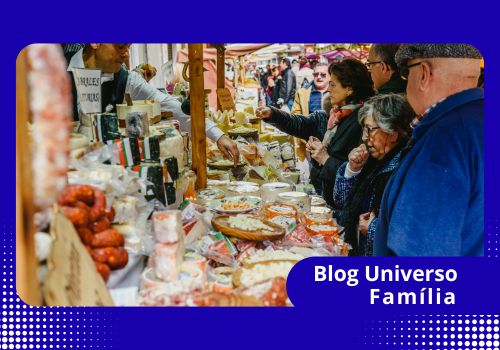Ads
When we talk about the most visited street marketsWe are referring to spaces that not only sell products, but also tell stories, traditions, and unique flavors.

These places are authentic cultural centers where commerce, gastronomy and daily life intertwine in surprising ways.
In this article, we'll explore which markets attract the most visitors, how they stand out in their cities, and why they represent much more than just sales.
We will also analyze recent data, original examples, and offer a practical overview for those who wish to experience the full picture.
Guide summary: First, we will define what makes a street market iconic; then, we will review the most visited markets in Mexico and the world.
Ads
Next, we'll explore its social and economic impact; finally, we'll conclude with tips for travelers and answer frequently asked questions.
What makes a street market unique?
Street markets combine culture, history and local economy.
It's not just about buying, but about living a multisensory experience: aromas, colors and sounds mix together, creating an atmosphere that cannot be replicated in shopping malls.
For example, The Merced Market in Mexico CityWith over 80 years of history, it not only offers food and crafts; it allows visitors to interact with vendors who know the city from its roots.
A useful analogy is to think of a street market as a open book of urban lifewhere each stall is a chapter and each conversation, a page that reveals local customs, culinary techniques and traditions.
This type of interaction makes the visitor part of the story, rather than a mere spectator.
Most visited street markets in Mexico
1. San Juan Market, Mexico City
He San Juan Market It is famous for its gourmet offerings and exotic products.
With over 100 years of history, it has become a benchmark for chefs, tourists and food lovers.
Here you can find everything from edible insects to unusual cuts of meat.
According to a report from the Mexico City government, More than 500,000 visitors come annuallymaking it one of the busiest markets in the capital.
2. Market 28, Cancun
Located in the tourist heart of Cancun, the Market 28 It combines handicrafts, traditional clothing and souvenirs with the warmth of human interaction.
Unlike other markets designed solely for tourists, this space allows you to negotiate prices and discover authentic products, creating a more personal and satisfying shopping experience.
Featured international street markets
Although Mexico has a rich tradition of markets, other cities around the world also attract crowds with their street markets:
Camden Market, London:
This market is not just a place to buy alternative clothing and urban art; it is a cultural space that brings together thousands of visitors every weekend.
Chatuchak Market, Bangkok:
With over 15,000 stalls, this Thai market is one of the largest in the world and a tourist magnet.
It offers everything from clothing to street food, standing out for its diversity and authenticity.
Economic and social impact
Street markets are local economic engines.
According to a study by World Trade Organization (WTO) of 2024Informal retail markets generate approximately 10% of urban employment in Latin Americawhich reflects its relevance not only in sales but also in job creation and social cohesion.
Furthermore, they encourage the circular economy:
Fresh produce and local crafts circulate directly between producers and consumers, reducing intermediaries and strengthening the cultural identity of each region.
Sensory experience: more than shopping
A stroll through a street market activates the senses in unexpected ways.
The eyes are filled with vibrant colors in fruits, textiles, and handicrafts; the sense of smell perceives aromas ranging from exotic spices to freshly baked bread.
The ear encounters the murmur of shoppers, local music, and the negotiations of vendors.
For example, in the La Merced MarketThe stalls selling dried chilies and aromatic herbs create an olfactory mix that no supermarket can replicate.
Thus, each visit becomes a sensory learning experience about ingredients, cooking techniques, and local traditions.
Tips for enjoying street markets
Arrive earlyYou'll avoid crowds and have access to fresh produce.
Negotiate with respectMany markets value human interaction, and friendly dialogue can enrich the experience.
Try the local cuisineEach market has its own culinary signature; from traditional tacos to unique snacks.
Observe the craftsmanshipThe details reveal ancestral techniques and contemporary creativity.
A well-planned visit transforms the shopping experience into a cultural and sensory discovery, elevating the value of the trip beyond the material.
Comparative table: most visited street markets
| Market | City / Country | Annual visitors | Specialty |
|---|---|---|---|
| San Juan Market | Mexico City | 500,000 | Gourmet and exotic products |
| Market 28 | Cancun | 350,000 | Handicrafts and souvenirs |
| Camden Market | London | 250,000 | Alternative fashion and urban art |
| Chatuchak Market | Bangkok | 400,000 | Street food and diverse clothing |
This table reflects the relevance of these spaces, combining visitor volume and unique offering.

Read more: Italian cuisine: the most iconic recipes
Final reflection
While exploring the most visited street marketsIt is clear that they are not simply places of commerce, but true cultural spaces where economy, tradition and creativity converge.
How often does a product matter more than it seems?
The experience of shopping in these markets reveals stories, flavors, and colors that are lost in conventional stores.
Visiting these markets allows you to connect with the essence of a city and its inhabitants, promoting conscious and enriching tourism.
Authenticity and human contact are the main attractions, and each visit leaves memories that transcend the purchase itself.
Read more: Street food: the most famous street food in the world
Frequently Asked Questions (FAQ)
1. What is the largest street market in Mexico?
He La Merced Market In Mexico City, it is considered the largest, with more than 3,000 stalls and a huge diversity of products.
2. Which street markets offer unique gastronomic experiences?
He San Juan Market in Mexico City and Chatuchak Market Bangkok stands out for its varied and exotic gastronomic offerings.
3. Is it recommended to negotiate prices in these markets?
Yes, negotiation is part of the cultural experience and allows you to interact directly with sellers in a respectful manner.
4. What precautions should I take when visiting a street market?
It is recommended to arrive early, take care of personal belongings and respect the dynamics of the stalls to fully enjoy the experience.
5. How do street markets contribute to the local economy?
They generate employment, promote local products and foster the circular economy, strengthening communities and traditions.